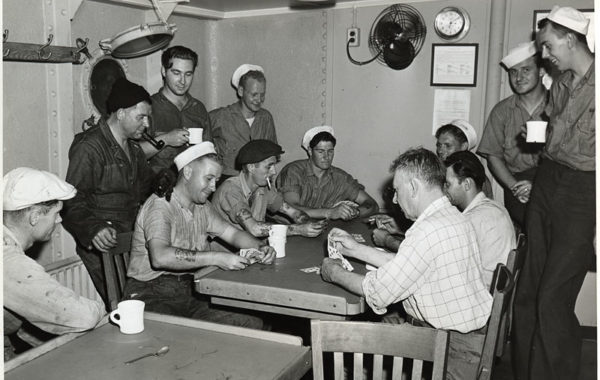World War II generated, and continues to generate, an avalanche of history books, novels, movies, and TV documentaries. But in all the words and images honoring, and rightly so, the heroism and sacrifices of the men and women who served in the United States’ war effort, one group is largely overlooked in these accounts – those who served in America’s Merchant Marine.
Merchant sailors’ acts of heroism were no less valorous and their sacrifices no less tragic than those of their brothers and sisters in arms, but their stories have been lost in the grand sweep of the war’s chronicle. The question is why?
The answer may lie with several stereotypes that marked merchant sailors during World War II. One popular misconception held that the dregs of society crewed merchant ships, since patriotic able-bodied young men volunteered for the armed services.
In fact, it was true that the U.S. Merchant Marine took some men who suffered from heart disease, who were missing one limb or had only one eye, factors that disqualified them from the fighting services. Boys 16 and 17 years old and men in their 60’s and 70’s served on merchant ships during the war. Some may not have been as able-bodied as Navy recruits and some may have been too young or too old for the draft, but they volunteered to serve their country nonetheless.
The generous physical and age requirements for service were the only way to meet the demand for crews to sail in the rapidly expanding fleet of civilian cargo ships authorized by Congress in 1936. The number of merchant seamen went from 55,000 in 1940 to 250,000 at the height of the war.
Another stereotype claimed that merchant sailors enjoyed higher pay than Navy sailors. This may have been true in some isolated categories, but overall pay grades between military and civilian sailors were comparable. The claims ignored the fact the Navy offered benefits unavailable to merchant sailors – paid leave, disability and death benefits, plus free medical care for service personnel and their dependents and a generous retirement pension.
By comparison, merchant mariners were paid when they signed on to a ship and their pay stopped as soon as their voyage ended or their ship was sunk. They received no travel allowance and had to pay for their uniforms.
Merchant seamen were among the first Americans killed in the war as their ships struck floating mines or were attacked in Allied convoys in 1940 and 1941. Indeed, 243 U.S. citizens died on American cargo ships sunk before the Japanese attacked Pearl Harbor. During the war, some 9,000 merchant seamen were killed, a number dwarfed by the more than 400,000 killed in the U.S. armed services. But the picture changes when considering the death rate for each service: 1 in 26 for the U.S. Merchant Marine, 1 in 34 for the Marines, 1 in 46 for the Army, and 1 in 114 for the Navy.
At the end of the war, returning veterans received benefits from the G.I. Bill, including education, unemployment support, home and small business loans, priority for postwar jobs and medical care for disabilities. None of these benefits were available for those who served in the Merchant Marine. It wasn’t until 1988, when Congress extended veteran status to merchant seamen, that these civilian sailors received recognition for their service. By then, however, it was far too late for many World War II veterans of the merchant fleet.


